|
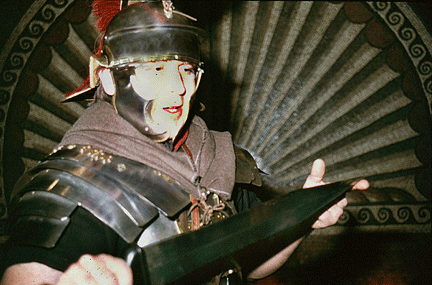 As dawn broke on a summer's day in 43 A.D.,
the history of Britain was about to be changed forever. An army of 40,000 men waded ashore
near Richborough in Kent and started fighting their way through the dense forests. That
army was led by Claudius, Emperor of Rome. The Romans had landed. As dawn broke on a summer's day in 43 A.D.,
the history of Britain was about to be changed forever. An army of 40,000 men waded ashore
near Richborough in Kent and started fighting their way through the dense forests. That
army was led by Claudius, Emperor of Rome. The Romans had landed.
At
that time much of Britain was inhabited by fierce Celtic tribes—the Dumnonii
(Cornwall), the Coritani(Yorkshire), the Catuvellauni(London), and the
Iceni(Lincolnshire), to name a few. The peaceful tribes of southern England
were beginning to tire of Celtic oppression and welcomed the Romans as their
liberators. For the
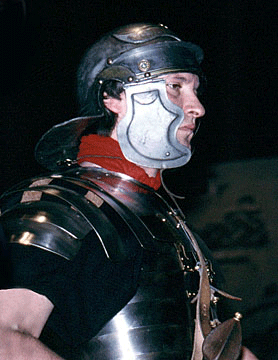 next four centuries, Britain was the Wild West of an
empire that stretched from the Mersey to the Euphrates. next four centuries, Britain was the Wild West of an
empire that stretched from the Mersey to the Euphrates.
The Roman army was an ethnic melting pot. Not one soldier in a hundred came
from Italy, let alone Rome. The army's backbone was the legion, heavy
infantry who could fight and build a road, raise a fortress or even bridge a
river. Legionaries hailed from Syria, Spain or South Wales. A unit may have
served in the same place for centuries.
Ex-soldiers settled where they had served and their native wives bore sons
who followed their fathers into the regiment, generation after generation.
Less than 20 years after the invasion, Queen Boudicca of the Iceni tribe,
outraged by Roman arrogance and greed, led a bloody revolt that left London
in ashes. Rome's revenge was horrible. Its legions slew 80,000 men, women
and children without mercy. After that the Pax Romana lasted for the
next three centuries.
The great legionary bases at Chester and York were the pillars of Roman
power. A third at Caerleon, in South Wales, guarded the road to Wales.
And then there was Hadrian's Wall...
The Romans never completely pacified the turbulent tribes of the north. To
keep the conquered ones penned in and their unconquered brothers fenced out,
the Emperor Hadrian, 79 years after the invasion, built a solid stone wall
clean across the Cumbrian Hills from sea to sea.

Seventy miles long, over 20 feet high in places, backed by a deep military
zone, scores of forts and guard towers and a war garrison of 13,000 men, the
Wall wasn't only the largest fortification in Europe, it was the greatest
feat of civil engineering the western world had seen. It was also the
supreme demonstration of the secret of Roman power, the ability to organize.
Today, Hadrian's Wall is a shadow of its former self, but what a shadow.
Running through some of Britain's most dramatic scenery above the Valley of
the South Tyne, it's easy to see, especially by car. Most of the surviving
stretches of wall worth visiting, as well as the fortresses that supported
it, are concentrated fairly close to the road over a stretch of about 20
miles, roughly between the towns of Corbridge and Birdsowald.
History buffs will delight in the Roman remains and excellent museums at
Corbridge, Chester and Vindolanda. For those who aren't so inclined, walking
at least a few hundred yards of the wall at Housesteads, with the wind
snapping in their faces and the grazing sheep for company, is a must. For
Hadrian's Wall was for 300 years the battlements of civilization.
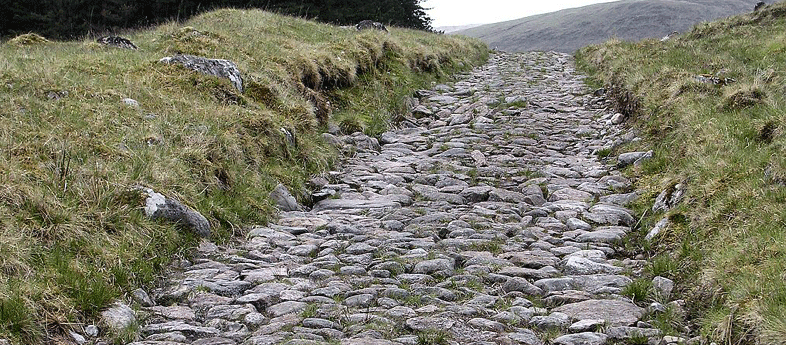
Roman roads helped keep the Roman peace. Except for motorways, any
English road that runs for more than a mile without bending is probably
one of the military roads that linked the cities of Britain. The A14,
formerly the Roman Ermine Street Road, the A5 across half of England,
the A46 from Leicester to Lincoln, or the A140 from Ipswich to Norwich
are all roads laid out by Roman surveyors.
Where is Roman Britain today?
 It's
around and beneath. Visitors shouldn't expect to find the Colosseum.
Fifteen hundred years haven't left much above ground. In St. Albans, the
ruins of a theater await its Roman audience. In Lincoln and Colchester,
the Roman arches still stand. It's
around and beneath. Visitors shouldn't expect to find the Colosseum.
Fifteen hundred years haven't left much above ground. In St. Albans, the
ruins of a theater await its Roman audience. In Lincoln and Colchester,
the Roman arches still stand.
Before venturing out to explore the few remaining ruins, visitors should
study the Roman displays in the Museum of London on Aldersgate Street.
Though Londinium was the physical focus of Roman Britain, Colchester,
not London, was intended by Claudius as the political focus. But London
soon overtook Colchester and became the capital of the province.
In 1954, a London building site yielded the Temple of Mithras on Queen
Victoria Street. The Museum of London exhibits artifacts from Britain's
most celebrated relic of that dark faith, which once rivaled
Christianity, along with the remains of a boat, once used to hall stone
from the quarries to the city walls, found near Blackfriars Bridge.
Imaginative displays feature all aspects of everyday Roman life. In
fact, one gallery looks out on a section of the actual Roman city wall.
Before the Roman conquest, Britain had no cities and towns. Chief among
the new communities of Roman Britain were the coloniae,
settlements of retired legionnaires who were granted an area of
land(praemia militae) when they left the legions. The Romans founded the
first colonia at Colchester(Camulodunum), then known officially
as Colonia Claudia Victricensis. Others followed at Gloucester (Glevum)
and Lincoln (Lindum).
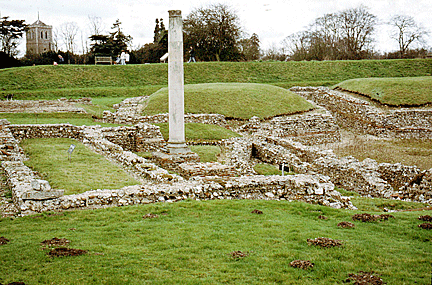 Safe
beneath the iron hand of the Roman army, these coloniae became
prosperous towns, with all the petty pomp and circumstance of a
miniature Rome, complete with temples and altars, forums and bathouses.
If a modern town is called Caer, or Car, or Caster, or Chester, or
Cester, or Xeter, it was Roman. Safe
beneath the iron hand of the Roman army, these coloniae became
prosperous towns, with all the petty pomp and circumstance of a
miniature Rome, complete with temples and altars, forums and bathouses.
If a modern town is called Caer, or Car, or Caster, or Chester, or
Cester, or Xeter, it was Roman.
Verulamium, the most important town in Roman Britain and a trading
center on the site of the present-day town of St. Albans twenty minutes
from London, was one such town. Today, a small, but unique museum
displays a huge variety of jewelry, coins, tableware and cooking pots
from Roman times. Besides colorful sections of painted walls and
demonstrations by local Roman re-enactment groups, the body of a Roman,
found in the Spring of 1989, lying in his original metal coffin is on
display. Nearby, the remains of a Roman theater used for bear baiting
and cock fighting as well as musical and dramatic performances gives
meaning to the museum's exhibits. The outlines of shops, that once lined
Watling Street, connecting Verulamium with Londinium, line the perimeter
of the theater.
The bustling Cotswold town of Cirencester offers another interesting
museum. The Corinium Museum, the town's Roman repository, features the
development of Cirencester and the Cotswolds with special reference to
the Roman period, including mosaics, jewelry, pottery and
reconstructions of rooms from a Roman house.
Roman Villas
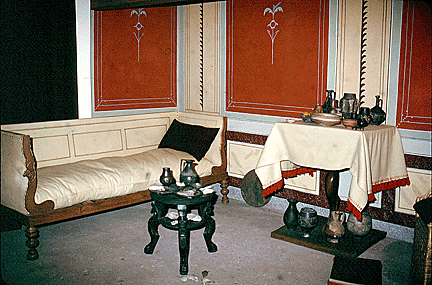 Hundreds
of Roman sites have been discovered. A gamekeeper digging for a ferret
in 1864 found the villa at Chedworth in the Cotswolds, one of more than
a dozen in the area. More recently in 1960, a man laying drains
discovered Fishbourne Palace near Chichester, the greatest Roman edifice
north of the Alps. Hundreds
of Roman sites have been discovered. A gamekeeper digging for a ferret
in 1864 found the villa at Chedworth in the Cotswolds, one of more than
a dozen in the area. More recently in 1960, a man laying drains
discovered Fishbourne Palace near Chichester, the greatest Roman edifice
north of the Alps.
Roman villas, country estates with small villages attached, flourished
throughout the Midlands and southern England. The owner was usually a
wealthy Briton who dressed like a Roman and spoke Latin to his dinner
guests, but used the local dialect to the farm hands.
Farm workers, like house servants, were probably slaves, who led a
simple life not without its comforts. Firewood and labor were cheap, and
every villa had hot baths and underfloor central heating. In fact, a
Roman-British house was probably the most comfortable dwelling built in
Britain until the late 20th century.
Chedworth Roman Villa, built around 120 A.D. and extended and occupied
until 400 A.D., offers good 4th-century mosaics in its bath suites and
dining room or triclinium, and its water shrine is still filled
by an ancient spring.
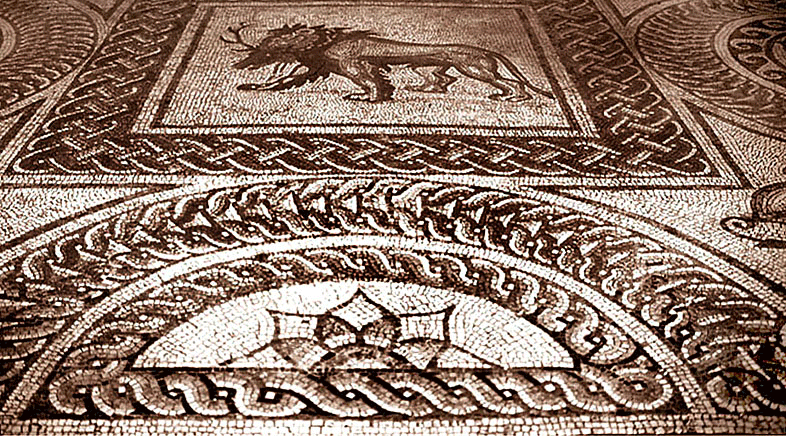
The Chedworth mosaics are just colored marble chips unless some
imagination is used. Imagine a nervous hostess who prayed that her fool
maid wouldn't drop the gravy on the new floor, that Flavia and Volumnia
would be on speaking terms for once, and that Uncle Marcus would try to
stay sober until after the children had gone to bed. For surely, under
the armor and imperious stone gaze, these were people very much like us.
 Among
the remains of Lullingstone Roman Villa are also splendid mosaic-tiled
floors, each depicting ancient legends. Four distinct periods of
building have been identified as well as one of the earliest private
Christian chapels. The excavation of the villa in 1949 uncovered some
remarkable artifacts. The plan of the building—including living room and
a bath house, with walls still standing 8 feet high in places—can be
clearly seen. Among
the remains of Lullingstone Roman Villa are also splendid mosaic-tiled
floors, each depicting ancient legends. Four distinct periods of
building have been identified as well as one of the earliest private
Christian chapels. The excavation of the villa in 1949 uncovered some
remarkable artifacts. The plan of the building—including living room and
a bath house, with walls still standing 8 feet high in places—can be
clearly seen.
The glory of Fishbourne Palace, like Chedworth, and Lullingstone in
Kent, and a dozen other sites, lies in its tesselated floors, the
brilliantly executed mosaics that seem to have been a British specialty.
After nearly 2,000 years beneath the soil, their sheer technical skill
showcases not only the craftsmanship of Roman Britain, but the
prosperity and self-assurance of that far-off age.
The barrack blocks of the Caerleon Legionary Museum are stones in the
grass until peopled with the Legionaries of Second Augusta who stumbled
shivering into the wet Welsh dawn and cursed the Silures, the centurion,
the rain and the day they ever joined. Exhibits here showcase the daily
life of one of Roman Britain's chief garrisons.
The Roman Baths
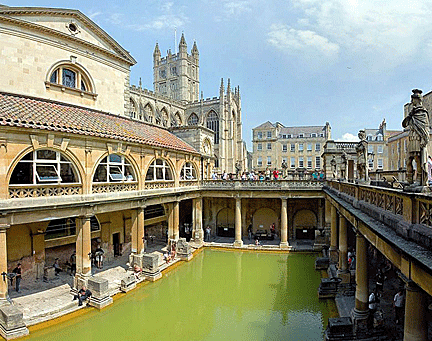 In
Bath, the steaming waters of Aquae Sulis still flow. The natural hot
springs attracted Romans from the mid to late first century and the town
soon developed as a spa, with the waters dedicated to Sulis-Minerva, a
blending of Roman and native deities. Of the public buildings so far
discovered, the chief are the baths. Their focal point is the Sacred
Spring, with its surrounding reservoir, from which the waters emerge at
46.5'C. Into this spring, the Romans cast votive offerings. Those since
recovered are displayed in the Roman Baths Museum. The Roman Baths of
Bath are probably Britain's greatest collection of Roman relics. In
Bath, the steaming waters of Aquae Sulis still flow. The natural hot
springs attracted Romans from the mid to late first century and the town
soon developed as a spa, with the waters dedicated to Sulis-Minerva, a
blending of Roman and native deities. Of the public buildings so far
discovered, the chief are the baths. Their focal point is the Sacred
Spring, with its surrounding reservoir, from which the waters emerge at
46.5'C. Into this spring, the Romans cast votive offerings. Those since
recovered are displayed in the Roman Baths Museum. The Roman Baths of
Bath are probably Britain's greatest collection of Roman relics.
Britain has over 250 Roman sites, a few elaborate, most simple
foundations. Can these dry stones speak? They can, but visitors
shouldn't expect them to shout out loud. In order to hear them, visitors
should take plenty of imagination with them and all the knowledge they
can, for four hundred years of Roman rule has, nevertheless, left their
mark.
< Back to
History Articles
Go to next History article >
|
